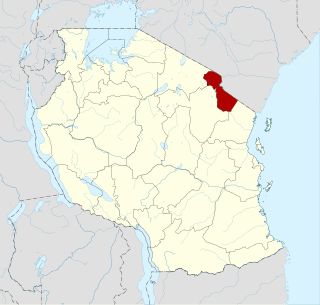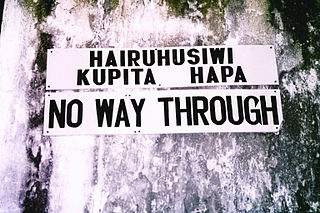Related Research Articles

Dar es Salaam is the largest city and financial hub of Tanzania. It is also the capital of Dar es Salaam Region. With a population of over six million people, Dar is the largest city in East Africa and the sixth-largest in Africa. Located on the Swahili coast, Dar es Salaam is an important economic centre and is one of the fastest-growing cities in the world.

Tanzania, officially the United Republic of Tanzania, is a country in East Africa within the African Great Lakes region. It borders Uganda to the north; Kenya to the northeast; the Indian Ocean to the east; Mozambique and Malawi to the south; Zambia to the southwest; and Rwanda, Burundi, and the Democratic Republic of the Congo to the west. Mount Kilimanjaro, Africa's highest mountain, is in northeastern Tanzania. According to the 2022 national census, Tanzania has a population of nearly 62 million, making it the most populous country located entirely south of the equator.

Demographic features of the population of Tanzania include population density, ethnicity, education level, health of the populace, economic status, religious affiliations, and other aspects of the population.

Dodoma, officially Dodoma City, is the legislative capital of Tanzania and is the administrative capital of both Dodoma Municipal Council and the entire Dodoma Region, with a population of 765,179. In 1974, the Tanzanian government announced that Tanzania's federal capital would be moved from Dar es Salaam to Dodoma for social and economic reasons and to centralise the capital within the country. It became the official capital in 1996.
The Zaramo people, also referred to as Dzalamo or Saramo, are a Bantu ethnic group native to the central eastern coast of Tanzania, particularly Dar es Salaam Region and Pwani Region. They are the largest ethnic group in and around Dar es Salaam, the former capital of Tanzania and the 7th largest city in Africa. Estimated to be about 0.7 million people, over 98% of them are Muslims, more specifically the Shafi'i school of Sunni Islam. Zaramo people are considered influential in Tanzania popular culture with musical genres like Sengeli originating from their commonity in Kinondoni District. Their culture and history have been shaped by their dwelling in both urban and rural landscapes.

Dar es Salaam Region is one of Tanzania's 31 administrative regions and is located in the east coast of the country. The region covers an area of 1,393 km2 (538 sq mi). The region is comparable in size to the combined land and water areas of the nation state of Mauritius Dar es Salaam Region is bordered to the east by Indian Ocean and it is entirely surrounded by Pwani Region. The Pwani districts that border Dar es Salaam region are Bagamoyo District to the north, Kibaha Urban District to the west, Kisarawe District to the south west and Mkuranga District to the south of the region. The region's seat (capital) is located inside the ward of Ilala. The region is named after the city of Dar es Salaam itself. The region is home to Tanzania's major finance, administration and industries, thus the making it the country's richest region. According to the 2022 census, the region has a total population of 5,383,728 and national census of 2012 had 4,364,541. The region has the highest population in Tanzania followed by Mwanza Region.

The Pare people are members of an ethnic group indigenous to the Pare Mountains of northern Tanzania, part of the Kilimanjaro Region. Historically, Pareland was also known as Vuasu and Vughonu to its inhabitants. The location lies on one of the northern routes of the historic East-African long-distance trade, connecting the hinterland with the coast of the Indian Ocean.

The Rangi are a Bantu-speaking ethnic group of mixed Bantu and Cushitic heritage in the Dodoma Region of central Tanzania. In 2022, the Rangi population was estimated to number 880,000.

The Kwere also known as Ngh'wele are a matrilineal ethnic and linguistic group native to Bagamoyo District and Chalinze District in Pwani Region of coastal Tanzania. The primary language spoken is Ngh'wele, called Kikwere in Swahili. The most famous person of Kwere descent is former President of Tanzania Jakaya Kikwete.

The Kuria people (also known as the AbaKurya, are a Bantu community in Tarime District of Mara Region in Tanzania and southern Kenya. Their homeland is bounded on the east by the Migori River and on the west by the Mara River estuary. Traditionally a pastoral and farming community, the Kuria grow maize, beans and cassava as food crops and coffee and maize as cash crops.

The Iraqw People are the Cushitic-speaking ethnic group inhabiting the northern Tanzanian regions. They are an abundant significant group in originating in southwestern Arusha and Manyara regions of Tanzania, near the Rift Valley. The Iraqw people settled in the southeast of Ngorongoro Crater in northern Karatu District, Arusha Region, where they remain the majority ethnic group. In Manyara region, the Iraqw are a major ethnic group in Mbulu District, Babati District and Hanang District.
The Alagwa are an ethnic group mostly based in the Kondoa District of the Dodoma Region in central Tanzania, an area well known for rock art. Smaller numbers of Alagwa reside in the Hanang district of the Manyara Region in Tanzania, as well. They speak the Alagwa language as a mother tongue, which belongs to the South Cushitic branch of the Afro-Asiatic family. In 2022, the Alagwa population was estimated to number 52,816 individuals, and Mous (2016) estimates the number of speakers to be slightly over 10,000.
The Burunge or Burungi are a Cushitic ethnic group and among Iraqhw Communities based in the Chemba District of Dodoma Region in central Tanzania. They speak the Burunge language as a mother tongue, which belongs to the South Cushitic branch of the Afro-Asiatic family. In 2002, the Burunge population was estimated at 13,000 individuals.
The Uluguru mountains are a mountain range in eastern Tanzania, named after the Luguru tribe. The main portion of the Uluguru mountains is a ridge running roughly north-south and rising to 2,630 metres (8,600 ft) altitude at its highest point. On the main Uluguru range, 50 villages touch the forest boundary and over 151,000 people are found within the mountain area, often at increasing densities at higher altitudes up to the forest boundary.
Gorowa is a Cushitic language spoken in Tanzania in the Dodoma and Manyara Regions.
Zaramo is a Niger-Congo language, formerly primary language of the Zaramo people of eastern Tanzania. Zaramo is also known as Zalamo, Kizaramo, Dzalamo, Zaramu, Saramo and, Myagatwa. The language is critically endangered. The ethnic population of the Zaramo people reaches about 200,000, yet there are only a few elderly speakers remaining.

Tanzania is a multilingual country. There are many languages spoken in the country, but no one language is spoken natively by a majority or a large plurality of the population. Swahili and English, the latter of which was inherited from colonial rule, are widely spoken as lingua francas. They serve as working languages in the country, with Swahili being the official national language. There are more speakers of Swahili than of English in Tanzania.
The Palors also known as Serer-Palor, among other names, are an ethnic group found in Senegal around the west central, west southwest of Thiès. They are a sub-group of the Serer ethnic group found in Senegal, the Gambia and Mauritania. Although ethnically Serers, they do not speak the Serer language but one of the Cangin languages. Their language is Palor.
Tanzania, officially known as the United Republic of Tanzania, is a mid-sized country in southeastern Africa bordering the Indian Ocean. It is home to a population of about 43.1 million people. Since gaining its independence from the United Kingdom in 1961, Tanzania has been continuously developing in terms of its economy and modern industry. However, the country’s economic success has been limited. Environmental obstacles, such as the mismanagement of natural resources and industrial waste, have been contributing factors and results of the relatively low economic status of the country. Tanzania’s annual output still falls below the average world GDP. In 2010, the GDP for Tanzania was US $23.3 billion and the GDP per capita was US $1,515. Comparatively, the GDP for the United States was $15.1 trillion and the GDP per capita was approximately $47,153. Eighty percent of the workers accounting for this annual output in Tanzania work in agriculture, while the remaining 20% work in industry, commerce, and government organizations. Such a heavy reliance on agriculture has placed a huge amount of strain on an already limited supply of viable land.
Martha A. S. Qorro is a linguist and an associate professor at the Centre for Communication Studies of the University of Dar es Salaam, known for her research into the use of the Kiswahili language as preferable language of instruction in Tanzania, and the Iraqw language.
References
- ↑ Harvey, Andrew (2019). "Gorwaa (Tanzania) — Language Contexts". Language Documentation and Description. 16: 127–168.
- ↑ Mlola, Gervase Tatah (2010). The Ways of the Tribe: A Cultural Journey across North-Eastern Tanzania. Dar es Salaam, Tanzania: E & D Vision Pub. pp. 116–131. ISBN 9789987521425.
- ↑ Seidel, A. (1900). "Die Sprache von Ufiomi in Deutsch-Ostafrika". Zeitschrift für afrikanische, ozeanische, und Ostasiatische Sprachen. 5: 165–175.
- ↑ Maganga, Faustin Peter. 1995. Local Institutions and Sustainable Resource Management: The case of Babati District, Tanzania. Doctoral dissertation. University of Dar es Salaam.